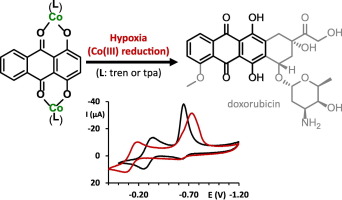当前位置:
X-MOL 学术
›
J. Inorg. Biochem.
›
论文详情
Our official English website, www.x-mol.net, welcomes your feedback! (Note: you will need to create a separate account there.)
Synthesis, characterization and albumin binding capabilities of quinizarin containing ternary cobalt(III) complexes.
Journal of Inorganic Biochemistry ( IF 3.9 ) Pub Date : 2019-12-17 , DOI: 10.1016/j.jinorgbio.2019.110963 Máté Kozsup 1 , Orsolya Dömötör 2 , Sándor Nagy 1 , Etelka Farkas 1 , Éva A Enyedy 2 , Péter Buglyó 1
Journal of Inorganic Biochemistry ( IF 3.9 ) Pub Date : 2019-12-17 , DOI: 10.1016/j.jinorgbio.2019.110963 Máté Kozsup 1 , Orsolya Dömötör 2 , Sándor Nagy 1 , Etelka Farkas 1 , Éva A Enyedy 2 , Péter Buglyó 1
Affiliation

|
Four Co(III) ternary complexes with the composition of [(Co(4 N))2(quin)](ClO4)4 or [(Co(4 N))2(quinS)](ClO4)3, where 4 N = tris(2-aminoethyl)amine (tren) or tris(2-pyridylmethyl)amine (tpa), quinH2 = quinizarin (1,4-dihydroxy-9,10-anthraquinone), quinSH3 = quinizarin-2-sulfonic acid (1,4-dihydroxy-9,10-anthraquinone-2-sulfonic acid), were synthesized, characterized and their human serum albumin (HSA) binding capabilities were also tested. The complexes can be considered as likely chaperons of quinizarins which are structural models for anthracycline-based anticancer drugs like doxorubicin. All the Co(III) complexes are dinuclear and were isolated as mixture of isomers. Comparison of the cyclic voltammograms of the free ligands and the appropriate Co(III) complexes revealed that the new signals belonging to reversible processes in the range -400-0 mV (vs. Ag/AgCl) for the complexes can be attributed to the reversible reduction of the Co(III) centre. These potentials are in the range of typical (O,O) chelated Co(III) ternary complexes bearing 4 N donor ligands and follow the order being more positive for the tpa containing complexes. Presence of the sulfonate group in the quinizarin results in slightly more negative reduction potential of the Co(III) complexes. HSA binding capabilities of the quinH2 and quinSH3 ligands as well as the appropriate complexes showed that quinSH3 has higher affinity to the protein than quinH2 while none of the complexes seem to bind to HSA.
中文翻译:

含奎尼萨林三元钴(III)配合物的合成,表征和白蛋白结合能力。
具有[[Co(4 N))2(quin)](ClO4)4或[[Co(4 N))2(quinS)](ClO4)3组成的四个Co(III)三元络合物,其中4 N =三(2-氨基乙基)胺(tren)或三(2-吡啶基甲基)胺(tpa),quinH2 =奎尼嗪林(1,4-二羟基-9,10-蒽醌),quinSH3 =奎尼嗪林-2-磺酸(1合成,表征,(4-二羟基-9,10-蒽醌-2-磺酸),还测试了它们与人血清白蛋白(HSA)的结合能力。该复合物可以被认为是奎尼沙林的可能伴侣,这是基于蒽环类抗癌药(如阿霉素)的结构模型。所有的Co(III)配合物都是双核的,并作为异构体混合物分离出来。游离配体和适当的Co(III)配合物的循环伏安图的比较显示,该配合物在-400-0 mV(vs. Ag / AgCl)范围内属于可逆过程的新信号可归因于可逆减少三氧化二钴中心。这些电势在典型的带有4 N供体配体的(O,O)螯合的Co(III)三元络合物的范围内,并且对于含tpa的络合物而言,呈正的顺序。奎尼沙林中磺酸盐基团的存在会导致Co(III)配合物的负还原电位稍高。quinH2和quinSH3配体的HSA结合能力以及适当的复合物显示,quinSH3对蛋白质的亲和力比quinH2高,而这些复合物似乎都不与HSA结合。复合物的Ag / AgCl)可以归因于Co(III)中心的可逆还原。这些电势在典型的带有4 N供体配体的(O,O)螯合的Co(III)三元络合物的范围内,并且对于含tpa的络合物而言,呈正的顺序。奎尼沙林中磺酸盐基团的存在导致Co(III)配合物的负还原电位稍高。quinH2和quinSH3配体的HSA结合能力以及适当的复合物显示,quinSH3对蛋白质的亲和力比quinH2高,而这些复合物似乎都不与HSA结合。复合物的Ag / AgCl)可以归因于Co(III)中心的可逆还原。这些电势在典型的带有4 N供体配体的(O,O)螯合的Co(III)三元络合物的范围内,并且对于含tpa的络合物而言,呈正的顺序。奎尼沙林中磺酸盐基团的存在会导致Co(III)配合物的负还原电位稍高。quinH2和quinSH3配体的HSA结合能力以及适当的复合物显示,quinSH3对蛋白质的亲和力比quinH2高,而这些复合物似乎都不与HSA结合。O)螯合带有4个N供体配体的Co(III)三元配合物,并且对于含tpa的配合物而言,其顺序是更阳性的。奎尼沙林中磺酸盐基团的存在会导致Co(III)配合物的负还原电位稍高。quinH2和quinSH3配体的HSA结合能力以及适当的复合物显示,quinSH3对蛋白质的亲和力比quinH2高,而这些复合物似乎都不与HSA结合。O)螯合带有4 N个供体配体的Co(III)三元复合物,并遵循对含tpa的复合物呈阳性的顺序。奎尼沙林中磺酸盐基团的存在会导致Co(III)配合物的负还原电位稍高。quinH2和quinSH3配体的HSA结合能力以及适当的复合物显示,quinSH3对蛋白质的亲和力比quinH2高,而这些复合物似乎都不与HSA结合。
更新日期:2019-12-18
中文翻译:

含奎尼萨林三元钴(III)配合物的合成,表征和白蛋白结合能力。
具有[[Co(4 N))2(quin)](ClO4)4或[[Co(4 N))2(quinS)](ClO4)3组成的四个Co(III)三元络合物,其中4 N =三(2-氨基乙基)胺(tren)或三(2-吡啶基甲基)胺(tpa),quinH2 =奎尼嗪林(1,4-二羟基-9,10-蒽醌),quinSH3 =奎尼嗪林-2-磺酸(1合成,表征,(4-二羟基-9,10-蒽醌-2-磺酸),还测试了它们与人血清白蛋白(HSA)的结合能力。该复合物可以被认为是奎尼沙林的可能伴侣,这是基于蒽环类抗癌药(如阿霉素)的结构模型。所有的Co(III)配合物都是双核的,并作为异构体混合物分离出来。游离配体和适当的Co(III)配合物的循环伏安图的比较显示,该配合物在-400-0 mV(vs. Ag / AgCl)范围内属于可逆过程的新信号可归因于可逆减少三氧化二钴中心。这些电势在典型的带有4 N供体配体的(O,O)螯合的Co(III)三元络合物的范围内,并且对于含tpa的络合物而言,呈正的顺序。奎尼沙林中磺酸盐基团的存在会导致Co(III)配合物的负还原电位稍高。quinH2和quinSH3配体的HSA结合能力以及适当的复合物显示,quinSH3对蛋白质的亲和力比quinH2高,而这些复合物似乎都不与HSA结合。复合物的Ag / AgCl)可以归因于Co(III)中心的可逆还原。这些电势在典型的带有4 N供体配体的(O,O)螯合的Co(III)三元络合物的范围内,并且对于含tpa的络合物而言,呈正的顺序。奎尼沙林中磺酸盐基团的存在导致Co(III)配合物的负还原电位稍高。quinH2和quinSH3配体的HSA结合能力以及适当的复合物显示,quinSH3对蛋白质的亲和力比quinH2高,而这些复合物似乎都不与HSA结合。复合物的Ag / AgCl)可以归因于Co(III)中心的可逆还原。这些电势在典型的带有4 N供体配体的(O,O)螯合的Co(III)三元络合物的范围内,并且对于含tpa的络合物而言,呈正的顺序。奎尼沙林中磺酸盐基团的存在会导致Co(III)配合物的负还原电位稍高。quinH2和quinSH3配体的HSA结合能力以及适当的复合物显示,quinSH3对蛋白质的亲和力比quinH2高,而这些复合物似乎都不与HSA结合。O)螯合带有4个N供体配体的Co(III)三元配合物,并且对于含tpa的配合物而言,其顺序是更阳性的。奎尼沙林中磺酸盐基团的存在会导致Co(III)配合物的负还原电位稍高。quinH2和quinSH3配体的HSA结合能力以及适当的复合物显示,quinSH3对蛋白质的亲和力比quinH2高,而这些复合物似乎都不与HSA结合。O)螯合带有4 N个供体配体的Co(III)三元复合物,并遵循对含tpa的复合物呈阳性的顺序。奎尼沙林中磺酸盐基团的存在会导致Co(III)配合物的负还原电位稍高。quinH2和quinSH3配体的HSA结合能力以及适当的复合物显示,quinSH3对蛋白质的亲和力比quinH2高,而这些复合物似乎都不与HSA结合。



























 京公网安备 11010802027423号
京公网安备 11010802027423号